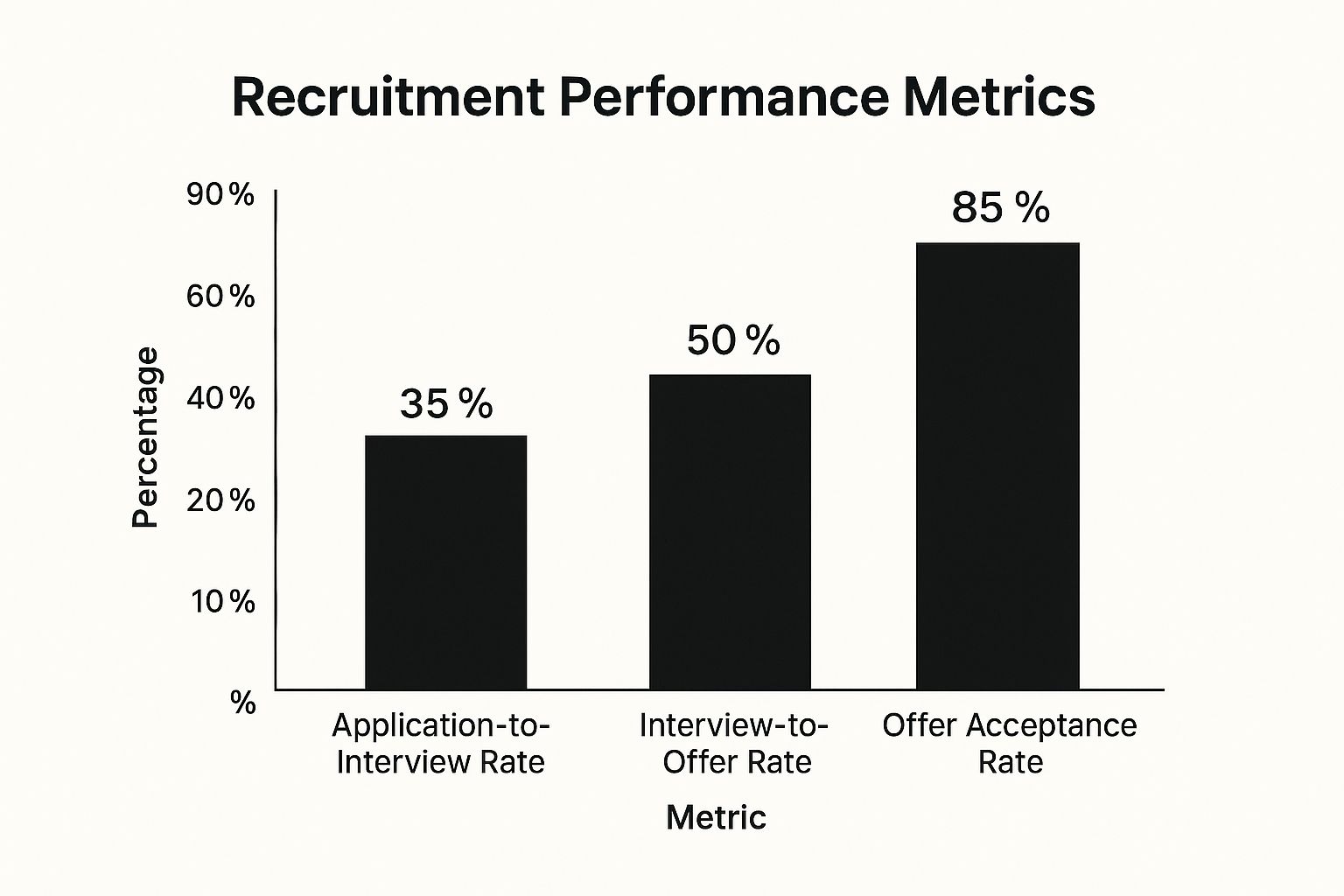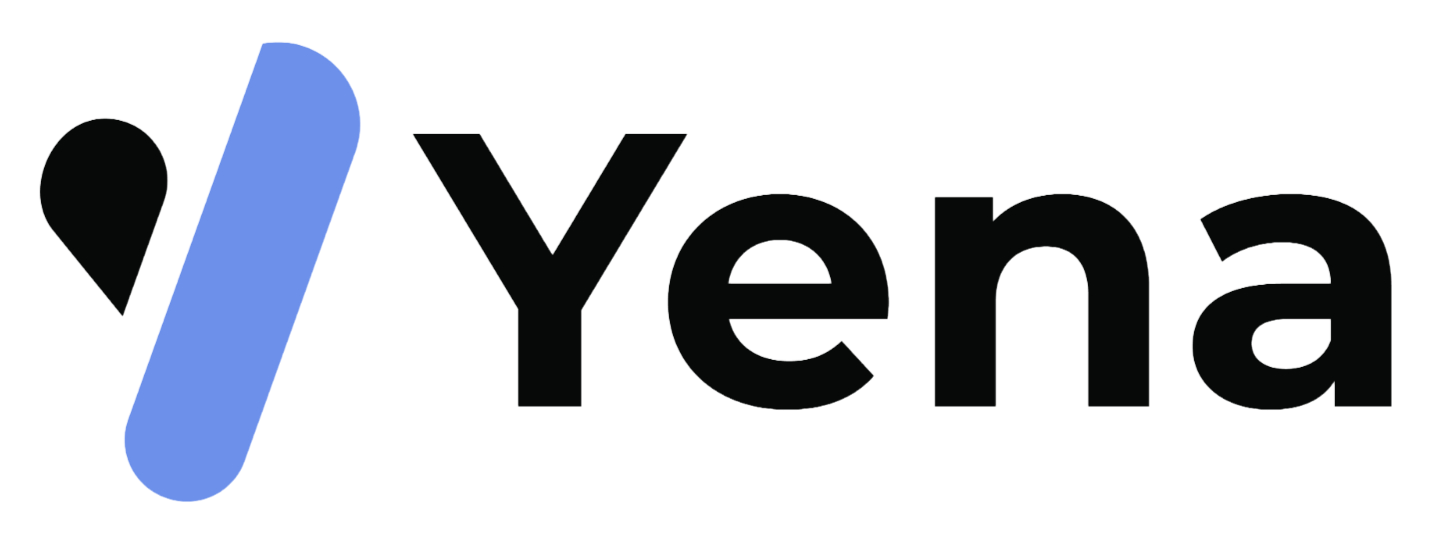Master the End to End Recruitment Process for Better Hiring
- Janis Kolomenskis
- Oct 15
- 18 min read
An end-to-end recruitment process is simply the entire journey of bringing a new person onto your team. It starts the moment you realise you need to hire and doesn't stop until that new hire is successfully onboarded and settled in. Think of it as a complete, connected strategy that ties everything together—from sourcing and screening to interviewing, making an offer, and finally, welcoming them aboard.
Defining Your End-to-End Recruitment Strategy
So, you want to build a hiring machine that not only finds but also keeps incredible talent? Let's get real about what an end-to-end recruitment process looks like and turn it into your company's secret weapon. This guide is your no-nonsense blueprint for creating a smooth journey from that first "hello" to a fantastic new hire.
In today's cut-throat talent market, having a modern, joined-up approach isn't just nice to have—it's essential. Every stage has to flow seamlessly into the next. Get it right, and you'll build a powerful system that speeds up hiring and, more importantly, massively boosts the quality of people you bring into the business.
Key Components of a Modern Recruitment Blueprint
Building a truly great process is about more than just filling a vacant seat. It's about crafting an experience that showcases your company's brand and values at every single step. To pull this off, you need to nail a few core areas:
The Candidate Experience: This is huge. You have to ensure every single applicant, whether they get the job or not, walks away feeling respected and positive about your company.
Hiring Manager Collaboration: Get in the trenches with your department heads! Work together to define roles, agree on what you’re looking for, and make smart, unified decisions.
Data-Driven Decisions: Stop guessing and start measuring. Use metrics to see what’s actually working, spot any bottlenecks holding you back, and constantly fine-tune your approach.
If you really want to get a grip on this, you need to understand what full-cycle recruiting is all about. It’s a mindset that empowers a single recruiter or a small team to own the entire hiring journey, which creates incredible consistency and a single, trusted point of contact for candidates.
A well-oiled end-to-end process isn't just an HR task; it's a core business strategy. It directly fuels your growth, sparks innovation, and shapes your company culture. You’re not just hiring for today—you’re building a talent pipeline for tomorrow.
Adapting to Regional Market Dynamics
Let's take the German market as a real-world example. Here, a well-thought-out, structured approach is absolutely key. The data shows that German companies have an average time-to-fill of around 43 days for skilled roles. It might be a little longer than the European average, but thanks to smarter digital recruiting, it's getting better.
And here’s another thing: with nearly 31.6% of professionals now working remotely, advertising a role as remote-first can get you up to 70% more candidate engagement. It's a game-changer. Understanding these local nuances is what separates good recruiting from great recruiting.
This infographic breaks down the key performance metrics you should be tracking to see how well your process is actually doing.

The data doesn't lie. It shows you exactly where candidates are dropping off, helping you fix the weak spots in your funnel, from the first screening call right through to the final offer.
If you’re ready to dig deeper and really polish every stage, check out our guide on the top recruiting best practices to attract talent in 2025. Consider it your map to building a world-class team, one brilliant hire at a time.
Finding and Engaging Top Talent Proactively
The hunt for incredible talent kicks off long before you ever post a job opening. This is where the real magic happens in the end to end recruitment process, and frankly, it's the part that separates the good recruiters from the great ones. Let's dive into the art of proactive sourcing and get you way ahead of the game.

Forget just posting and praying. The modern recruiting playbook is all about building strong talent pipelines with a savvy mix of technology and genuine human connection. This means going after passive candidates—those high-performers who are crushing it in their current roles and aren't even looking for a new one. They're the ones you really want.
Mastering the Art of Proactive Sourcing
Think of proactive sourcing as being a talent detective. You’re not just plugging a hole in the org chart; you're building a community of potential future colleagues who already know, like, and respect your brand. It’s a long game, but it pays off massively, ensuring you have a warm pool of candidates ready to go the moment a position opens up.
So, where do you start? Focus your efforts where the pros hang out, and that's not always the obvious places.
Professional Networks: Sure, LinkedIn is the undisputed king, but don't stop there. If you're hiring in Germany or the wider DACH region, platforms like Xing are absolutely vital for tapping into local talent.
Niche Online Communities: These are absolute goldmines. We're talking about places like GitHub for developers, Dribbble for designers, or hyper-specific Slack and Discord channels. This is where the truly passionate experts live and breathe their craft.
Social Media: You'd be surprised how effective platforms like X (formerly Twitter) can be. Following and engaging with industry thought leaders can lead you directly to the perfect person for your role—or at least someone who knows them.
The goal is to show up where your ideal candidates are already spending their time. When you participate authentically in these communities, you build credibility. Your outreach suddenly feels less like a cold call and more like a chat with a peer.
Choosing the Right Channels for Your Search
Not all sourcing channels are created equal. You need to be strategic about where you invest your time and budget. A job board might be great for entry-level roles, but you'll need a more targeted approach for that senior-level specialist.
Here's a quick comparison to help you decide where to focus your energy:
Sourcing Channel Effectiveness Comparison
Sourcing Channel | Best For | Average Engagement Rate | Typical Cost |
|---|---|---|---|
LinkedIn Recruiter | Highly specific senior & niche roles | 20-30% | High (Subscription) |
Employee Referrals | High-quality, culturally-aligned candidates | 40-50% | Low to Medium (Bonuses) |
Niche Communities | Passionate technical & creative talent | Varies (High if authentic) | Low to None |
Professional Events | Building genuine, face-to-face connections | High | Medium to High (Tickets/Travel) |
Traditional Job Boards | High-volume, junior to mid-level roles | 2-5% | Low to Medium (Per post) |
As you can see, investing in direct outreach and leveraging your internal network often yields much better engagement than passive methods. The key is to build a multi-channel strategy that covers all your bases.
Turning Cold Outreach into Warm Conversations
Okay, you've found some promising people. Now what? This is the moment of truth: engagement. You have to remember you're interrupting someone's day, so your approach needs to be sharp, respectful, and compelling.
Generic, copy-paste templates are a one-way ticket to the trash folder. A message that gets a reply is personal, brief, and focuses entirely on the candidate, not just your company's needs.
Pro Tip from the Trenches: Keep your first message incredibly short and show you've done your homework. Mention a recent project they shipped, an article they wrote, or a mutual connection. This tiny bit of effort signals that you see them as an individual, not just a keyword match, and it will skyrocket your response rate.
Here's a simple, no-fail framework for an effective outreach message:
The Personalised Hook: Start with something just for them. "I was really impressed with your talk on AI ethics at the Berlin Tech Summit."
The 'Why You?': Briefly explain what caught your eye. "We're building a team that's tackling similar challenges, and your expertise really stood out."
The 'What Now?': Make a low-commitment ask. You're offering a conversation, not a job interview. "Would you be open to a quick, 15-minute chat next week to share some ideas?"
The Easy 'Yes': Make it incredibly simple for them to respond. Suggest a specific time or drop in a scheduling link.
This approach flips the script from a transactional request to a peer-to-peer discussion. It's how you start building a real relationship, whether they're a fit for this role or one a year from now.
And don't forget your most powerful sourcing tool: your current team! Dive into our guide on employee referral programs that actually drive results to see how you can tap into this incredible source of high-quality, pre-vetted candidates.
Designing a World-Class Interview Process
Right, you’ve gathered a pool of fantastic candidates—that's a huge win! But now comes the real test in your end-to-end recruitment process: figuring out who is the absolute best fit. This is where you move from potential to proof, and a well-designed interview process is your most powerful tool for getting it right.

Let's dive into building an interview and selection system that’s both incredibly insightful and brilliantly efficient. It’s all about getting beyond what’s on the CV to uncover a candidate’s true problem-solving skills, how they think, and, crucially, if they’ll genuinely thrive in your company culture.
Structuring Interviews That Reveal True Potential
A great interview isn’t just a casual chat; it's a structured investigation. The whole point is to create a consistent, fair, and repeatable experience so you can compare candidates on an equal footing. That means ditching the random, off-the-cuff questions and getting much more deliberate.
To pull this off, you need a smart mix of question types that probe different competencies. When you combine them, you get a much richer, more complete picture of who you're talking to.
Behavioural Questions: These are gold. They work on the principle that past performance is the best predictor of future behaviour. You ask candidates to tell you about specific situations from their past jobs. Think along the lines of: "Tell me about a time you had to juggle conflicting priorities. How did you decide what to tackle first?"
Situational Questions: These throw a hypothetical, job-related scenario at the candidate to see how they’d think on their feet. For example: "Imagine a key project you're leading is suddenly behind schedule. What are your first three steps?"
This structured approach forces candidates to provide solid evidence of their skills instead of just making abstract claims. It’s the difference between asking, "Are you a good team player?" and "Describe a time you disagreed with a colleague and how you resolved it." The second question gives you real insight you can actually use.
Implementing Relevant and Fair Assessments
Sometimes, a conversation just isn't enough, especially for highly technical or creative roles. This is where practical assessments come in, but they have to be designed thoughtfully. A poorly designed test can easily scare away the very people you want to attract.
The golden rule is this: any assessment must genuinely mirror the actual demands of the job. Please, avoid the generic brainteasers or overly academic problems unless they directly relate to the day-to-day work.
For a software developer, for instance, a small, time-boxed project—like fixing a bug in existing code or building a simple feature—is far better than a vague coding puzzle. It directly tests their real-world skills in a relevant context.
A well-designed technical task doesn't just evaluate skill; it gives the candidate a taste of the actual work they'll be doing. This two-way assessment helps them decide if the role is a good fit for them, too, leading to better long-term retention.
This approach ensures your assessment is a fair evaluation tool and a positive part of the overall candidate journey. Remember, the interview experience itself is a powerful branding tool. You can learn more about acing the interview experience for top talent in our detailed guide.
Training Your Team to Make Data-Informed Decisions
Your interview process is only as strong as the people conducting the interviews. Let's be honest, unconscious bias is one of the biggest threats to making great hires, and even the most well-intentioned interviewer can fall into its traps. That's why training your interview panel is absolutely non-negotiable.
Common biases can sneak in and derail the whole process:
Affinity Bias: The tendency to warm to people who are just like us—same background, interests, or personality.
Halo/Horns Effect: Letting one really strong positive (or negative) trait colour your entire perception of a candidate.
Confirmation Bias: Actively looking for information that confirms your initial gut feeling, whether it’s good or bad.
The best way to combat these is with a system. Start by creating a standardised scorecard for every role. This document should clearly outline the core competencies and skills needed, with a simple rating scale (e.g., 1-5) for each one.
During the post-interview debrief, make each interviewer share their scores and provide specific, evidence-based examples from the conversation to justify their ratings. This forces the discussion to be about observable behaviours ("The candidate clearly explained their thought process on the coding challenge") rather than vague feelings ("I just got a really good vibe from them").
This data-informed approach transforms your hiring from a subjective art into a reliable science. It builds a system where your final choice is based on solid, collective evidence—not just a single person's gut feeling. This is how you build an engine for making brilliant hiring choices, every single time.
Crafting Offers That Candidates Eagerly Accept
This is it. The offer stage isn’t just a formality; it's the grand finale of your entire recruitment journey. This is the moment that seals the deal, turning a fantastic candidate into your next amazing team member. Let’s break down how to put together a job offer that people are genuinely thrilled to sign.
This is your chance to really show the candidate you’ve been paying attention. A killer offer feels personal. It proves you understand what drives them, whether it’s a clear path for promotion, better work-life balance, or the chance to sink their teeth into exciting new projects. It’s the final, powerful impression you leave them with.
Getting the Numbers Right: Competitive and Fair Offers
Before you can wow a candidate, you need to ground your offer in reality. That means doing your homework to benchmark salaries properly, making sure you’re competitive without completely blowing your budget. Don't just rely on what the last person in the role was paid—the market moves fast.
You need to juggle a few key variables:
Location, Location, Location: A software developer role in Munich will command a very different salary than the same job in Leipzig. Geography matters, a lot.
Industry Standards: What are your direct competitors offering for similar talent? Tools like Glassdoor and Payscale are invaluable here, as are specialised industry reports.
The Candidate's Unique Value: You have to account for their specific skills, years in the trenches, and any rare expertise they’re bringing to the team.
Understanding regional differences is also a game-changer, especially if you’re hiring from different markets. For example, when hiring software developers in Eastern Europe, cost-efficiency is a major factor. In 2025, you can expect average hourly rates to range from 15-25 euros for junior talent to over 50 euros for senior specialists, depending on the country. Having this kind of intel helps you build an offer that’s both competitive and smart. You can find more insights on the cost of hiring in Eastern Europe on wild.codes.
It's More Than Just the Money: Communicating Your Full Value
Here’s where so many companies drop the ball. A job offer is so much more than a number on a page. The real magic happens when you sell the total value proposition—the complete picture of what makes working at your company an unmissable opportunity.
Think way beyond the payslip. Your offer should be an enthusiastic showcase of every single perk and benefit that makes your organisation a brilliant place to build a career.
Don't just list benefits; explain what they mean. Instead of "Health Insurance," try "Comprehensive health coverage that gives you and your family total peace of mind." Frame every single element around how it will genuinely improve the candidate’s life.
Your goal is to paint a vivid, exciting picture of their future with you. Talk about the professional development budget, the mentorship programmes, your awesome flexible working policy, and any unique cultural perks. This is how you stand out from the crowd and win over top talent who might be juggling multiple offers.
Navigating Negotiations and Sealing the Deal
Even with a perfectly crafted offer, you should always be ready for a bit of negotiation. Don’t see it as a battle! Think of it as the final collaborative step to make sure everyone walks away happy. If a candidate comes back with a counteroffer, take a breath, stay calm, and listen carefully to understand where they’re coming from. Is it purely about the salary, or is there something else at play?
Once you’ve shaken hands on the final agreement, it’s time to move on to the essential pre-employment checks. These are the last few administrative hurdles before the real fun begins. This usually involves:
Reference Checks: A quick chat with former managers to confirm the candidate's skills and how they work.
Background Screening: Running any necessary checks required by local laws and regulations.
The Formal Offer Letter: Sending over the official contract with all the agreed-upon terms clearly laid out, ready for their signature.
Handling these final steps with speed and enthusiasm keeps the momentum high. It guarantees a smooth, compliant, and exciting transition that gets your new hire pumped for their first day.
Creating an Onboarding Experience That Retains Talent
So, you've made the hire! Popping the champagne is great, but don't close the book on the end to end recruitment process just yet. The moment a candidate signs their contract is when the real work begins. Onboarding is that final, crucial phase where you turn a promising new hire into a powerhouse team member who's in it for the long haul.

Let's be clear: a truly stellar onboarding experience is so much more than a quick office tour and a mountain of HR paperwork. It’s a carefully crafted programme designed to weave your new hire into the company's social and professional fabric. When done right, you make them feel valued and ready to rock from the second they step through the door, slashing their ramp-up time and sending morale through the roof.
Building a Structured 30-60-90 Day Plan
One of the most powerful tools in my onboarding toolkit is the 30-60-90 day plan. This isn't just another to-do list; it’s a strategic roadmap that provides crystal-clear direction, sets achievable goals, and gives your new employee a direct path to scoring early wins. It’s all about breaking down those overwhelming first three months into manageable, confidence-boosting chunks.
This plan single-handedly demystifies what’s expected of them and empowers them to start contributing in a meaningful way, fast. It literally shows them what success looks like at each milestone.
Here’s a breakdown I’ve seen work wonders:
First 30 Days (Learning & Immersion): The entire focus here is on soaking everything up like a sponge. Think company culture, key team members, product deep dives, and getting the hang of internal systems. The goal is pure absorption, not massive output.
Next 30 Days (Contributing & Applying): Now it's time to start putting that knowledge into practice. The new hire should begin taking ownership of smaller tasks, chipping in on team projects, and even spotting areas where things could be improved. This is the shift from learning to doing.
Final 30 Days (Owning & Driving): At this point, the training wheels come off. Your new team member should be operating with more independence, managing their own projects, and actively driving results. This is where they truly start to own their role.
This phased approach builds in a natural rhythm for check-ins and feedback, making sure your new hire feels supported every step of the way. It’s a simple concept, but it’s incredibly effective at building momentum from day one.
A great 30-60-90 day plan answers the new hire's biggest unspoken question: "How can I succeed here?" It turns ambiguity into a clear, actionable plan for making an immediate impact.
Fostering Connections from Day One
While plans and processes are the skeleton, the human element is the heart of any great onboarding experience. For someone to stick around, they need to feel like they belong. Fostering those initial connections with the team is absolutely non-negotiable.
This should kick off before their first day even arrives. A simple welcome message from the team on Slack or a quick intro email from their direct manager can make a world of difference. It replaces those first-day jitters with genuine excitement.
Assigning an onboarding buddy is another fantastic tactic I swear by. This isn't their manager, but a friendly peer who can answer all the "silly" questions—like where the best coffee is or how the printer really works. It gives them an instant, informal support system.
As the global talent market heats up, a world-class onboarding process becomes your secret weapon. The end-to-end recruitment process in Eastern Europe, for example, has seen explosive growth in the IT sector. The region is home to over 3.5 million ICT specialists, with more than 1.5 million of them being software developers. This incredible talent pool highlights the need not just for efficient recruitment, but for robust onboarding that convinces these skilled professionals to stay.
Interestingly, we can borrow some great ideas from other fields. As this guide on customer onboarding best practices points out, ensuring a smooth transition and providing clear guidance are fundamental to retention. That lesson applies perfectly to new employees, too. A phenomenal onboarding experience is the final, perfect touch on your recruitment efforts.
How to Measure and Optimise Your Recruitment Success
Let's be honest, a world-class end-to-end recruitment process is never set in stone. It's a living, breathing thing that needs constant attention and tweaking. If you really want to build a hiring engine that gets stronger with every hire, it's time to stop guessing and start measuring what actually works.
This is where data steps in as your secret weapon. By tracking the right key performance indicators (KPIs), you can transform a mountain of recruitment data into a clear roadmap for improvement. It’s about looking beyond just the number of people you’ve hired and truly understanding the health of your entire process, from that first outreach call to a new hire's first day.
Focusing on the Metrics That Matter
To get a real handle on your performance, you need to cut through the noise and focus on a handful of essential metrics. These are the numbers that give you the critical insights to spot bottlenecks, celebrate what's working, and make smart, evidence-based decisions about where you should be putting your energy.
Think of these as the core dials on your recruitment dashboard:
Time to Fill: This is the stopwatch on your process—how many days does it take from opening a job to getting an offer accepted? If this number keeps creeping up, it’s a massive clue that something in your screening or interviewing stage is causing a hold-up.
Cost per Hire: Simply put, this is your total recruitment spend divided by the number of successful hires. It's an absolute must-have for budgeting and proving the value of your team's efforts to the higher-ups.
Quality of Hire: Are you actually hiring people who excel and stay? This metric, often gauged through performance reviews after 6-12 months, is the ultimate litmus test of your entire process.
Candidate Satisfaction: A quick survey after an interview can give you priceless, unfiltered feedback on the candidate experience. Low scores here are a serious warning sign that could be damaging your employer brand.
The goal isn't just to hoard data; it's to use it to tell a story. For example, if your Time to Fill is a bit high but your Quality of Hire is through the roof, you might be perfectly fine with a more deliberate process. But if both are struggling? That's your cue to make a change, fast.
Turning Insights into Action
Data is completely useless if you don't do anything with it. While a modern Applicant Tracking System (ATS) is brilliant for collecting all this information automatically, the real magic happens when you use those numbers to ask the hard questions and drive real improvements.
Get into a rhythm of reviewing your metrics with hiring managers. Are you seeing a pattern of candidates dropping out after the same interview stage? Maybe that technical test is way too difficult, or perhaps the interviewers themselves need a bit more training.
Don't be afraid to ask for feedback directly, either. Both the candidates you hired and the ones you didn't are sitting on a goldmine of insights. Digging into these numbers and stories is how you future-proof your hiring.
For an even deeper look at this, check out our guide on the essential recruiting metrics to improve hiring in 2025. This constant cycle of measuring, analysing, and optimising is what turns a good recruitment process into a truly unbeatable one.
Got Questions About Your Recruitment Process? Let's Dig In.
Every hiring team runs into the same practical questions eventually. Let's tackle a few of the most common ones that come up when you're trying to build a truly effective, end-to-end recruitment machine.
How Long Should This Whole Process Actually Take?
Ah, the million-dollar question! There's no single, perfect answer here because it really hinges on the role's complexity and your industry. But, if you're looking for a solid benchmark, aim for somewhere between 30 to 45 days for most professional roles. That's from the day the job goes live to the day your top candidate signs on the dotted line.
Of course, there are exceptions. Scrappy startups can sometimes wrap things up in under three weeks, moving at lightning speed. On the flip side, if you're hunting for a highly specialised engineer or a C-suite executive, don't be surprised if the search stretches to 60 days or more.
The real secret isn't just about raw speed. It's about maintaining momentum.
A process that feels responsive and keeps moving forward will always create a better candidate experience than one that's fast but feels chaotic and disorganised.
Map out your stages, spot potential bottlenecks (hello, interview scheduling!), and be upfront about the timeline with everyone involved.
What’s the One Metric That Truly Matters for Success?
While everyone tracks things like Time to Fill and Cost per Hire – and you absolutely should – the true north star of recruitment success is Quality of Hire. This is the metric that answers the most important question of all: "Did we actually hire someone great who succeeds and sticks around?"
It's a bit trickier to measure, I'll admit. You often have to look at a new hire's first performance review, their direct impact on team goals after six months, and, of course, their retention rate. A consistently high Quality of Hire is the ultimate proof that your entire system, from sourcing to selection, is working beautifully.
How Can Small Businesses Compete for Talent Without a Huge Budget?
You absolutely do not need a massive war chest to win top talent! Small businesses can punch way above their weight by leaning into their natural strengths: creativity, agility, and a killer candidate experience.
Make referrals your superpower: Your current team is a goldmine. They know your culture and they know great people. An incentivised referral programme is your best friend.
Get scrappy with your tools: You can get so much done with free or low-cost options. LinkedIn is a powerful sourcing tool, and there are plenty of great, free applicant tracking systems out there to keep you organised.
Sell your story, not just a job: This is your biggest advantage! Talk about your mission, the unique culture you're building, and the real, tangible impact a new person can make. That’s something a corporate giant can rarely offer.
A thoughtful, personal, and efficient process often means more to a candidate than all the fancy perks in the world.
Ready to turn your team's network into your most powerful recruiting tool? Yena uses AI to map the warm introduction paths to the talent you need to reach. Find out how to get a 67% response rate with our unique approach at https://yena.ai.

Comments